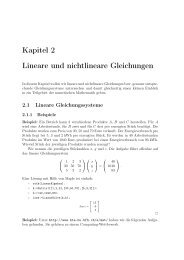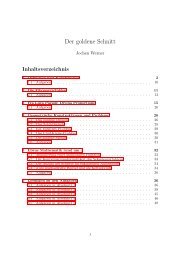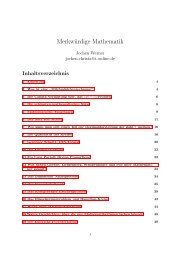BAIL 2006 Book of Abstracts - Institut für Numerische und ...
BAIL 2006 Book of Abstracts - Institut für Numerische und ...
BAIL 2006 Book of Abstracts - Institut für Numerische und ...
You also want an ePaper? Increase the reach of your titles
YUMPU automatically turns print PDFs into web optimized ePapers that Google loves.
O. SHISHKINA, C. WAGNER: Bo<strong>und</strong>ary and Interior Layers in Turbulent Thermal<br />
Convection<br />
✬<br />
✫<br />
Bo<strong>und</strong>ary and Interior Layers in Turbulent Thermal Convection ∗<br />
1. Introduction<br />
O. Shishkina & C. Wagner<br />
DLR - <strong>Institut</strong>e for Aerodynamics and Flow Technology,<br />
Bunsenstrasse 10, 37073 Göttingen, Germany<br />
Olga.Shishkina@dlr.de, Claus.Wagner@dlr.de<br />
Numerous scientifical problems and industrial applications require solutions <strong>of</strong> the Rayleigh-<br />
Bénard problem, i.e. turbulent convection <strong>of</strong> fluids heated from below and cooled from above,<br />
with the Rayleigh number (Ra) from 10 5 up to 10 20 . For a review on this classical problem and<br />
for the references to earlier literature we refer to the paper Ahlers, Grossmann and Lohse [1].<br />
Since the diffusion coefficient in the Navier-Stokes equation, which is inversely proportional to<br />
the square root <strong>of</strong> Ra, is very small, the solution - both the temperature and the velocity fields -<br />
have very thin bo<strong>und</strong>ary layers near the horizontal walls. For moderate Rayleigh numbers (from<br />
10 5 up to 10 8 ) interior layers, i.e. thermal plumes, are also observed. The bo<strong>und</strong>ary layers, the<br />
thermal plumes and the turbulent backgro<strong>und</strong> are indicated, respectively, by high, moderate and<br />
small values <strong>of</strong> the temperature gradient norm and, hence, by large, moderate and small values<br />
<strong>of</strong> the thermal dissipation rate. By means <strong>of</strong> direct numerical simulations (DNS) we invesigate<br />
bo<strong>und</strong>ary and interior layers which take place in turbulent Rayleigh-Bénard convection.<br />
2. Governing equations and the numerical method<br />
The governing dimensionless equations for the Rayleigh-Bénard problem in Boussinesq approximation<br />
can be written in cylindrical coordinates (z, r, ϕ) as follows<br />
ut + u · ∇u + ∇p = Γ −3/2 Ra −1/2 P r 1/2 ∇ 2 u + T z, (1)<br />
Tt + u · ∇T = Γ −3/2 Ra −1/2 P r −1/2 ∇ 2 T, (2)<br />
∇ · u = 0, (3)<br />
where u is the velocity vector, T the temperature, ut and Tt their time derivatives, p the<br />
pressure. Here Ra = αgH 3 ∆T/(κν) denotes the Rayleigh number, P r = ν/κ the Prandtl<br />
number, Γ = D/H the aspect ratio with H the height and D the diameter <strong>of</strong> the cylindrical<br />
container. Further, α is the thermal expansion coefficient, g the gravitational acceleration, ∆T<br />
the temperature difference between the bottom and the top plates, ν the kinematic viscosity and<br />
κ the thermal diffusivity. The dimensionless temperature varies between +0.5 at the bottom<br />
plate to −0.5 at the top plate. An adiabatic lateral wall is prescribed by ∂T/∂r = 0. Finally, on<br />
the solid walls the velocity field vanishes according to the impermeability and no-slip conditions.<br />
To investigate turbulent Rayleigh-Bénard convection in cylindrical containers <strong>of</strong> the aspect<br />
ratios Γ = 10 and Γ = 5 for Ra from 10 5 to 10 7 and P r = 0.7 we conducted DNS. The simulations<br />
were performed with the fourth order accurate finite volume method developed for solving (1)<br />
– (3) in cylindrical coordinates on staggered non-equidistant grids. For the numerical method<br />
used in the DNS we refer to [2].<br />
∗ The work is supported by Deutsche Forschungsgemeinschaft (DFG) <strong>und</strong>er the contract WA 1510-1<br />
Speaker: SHISHKINA, O. 138 <strong>BAIL</strong> <strong>2006</strong><br />
1<br />
✩<br />
✪
















